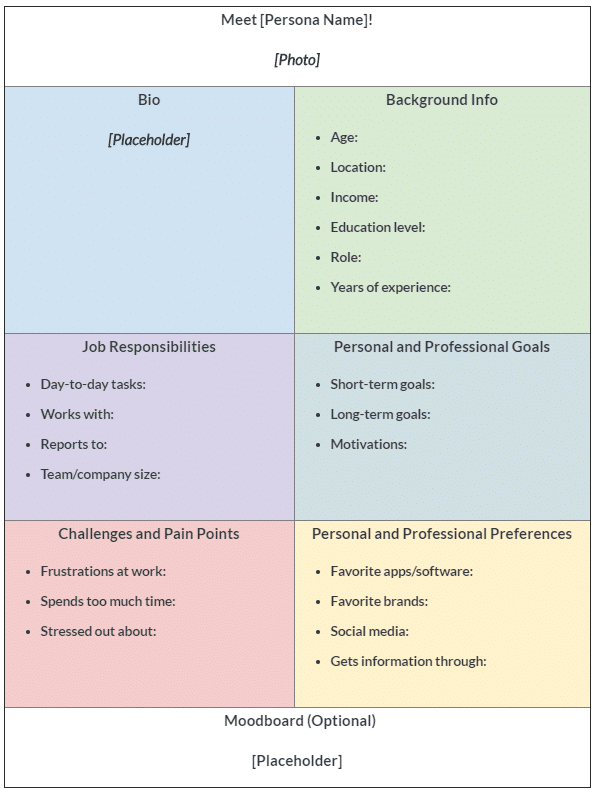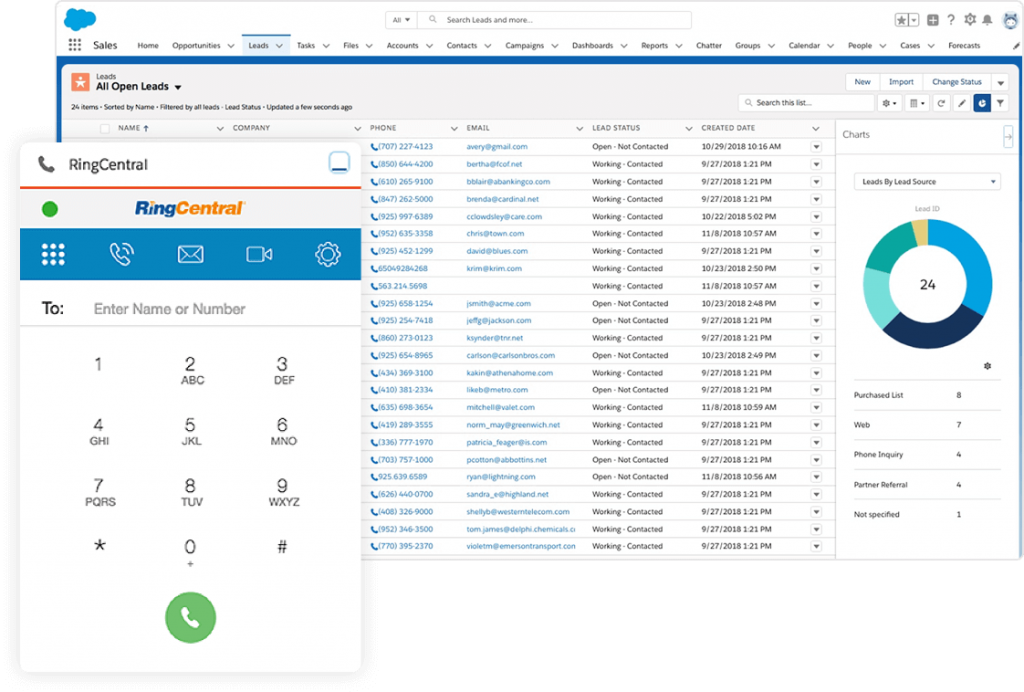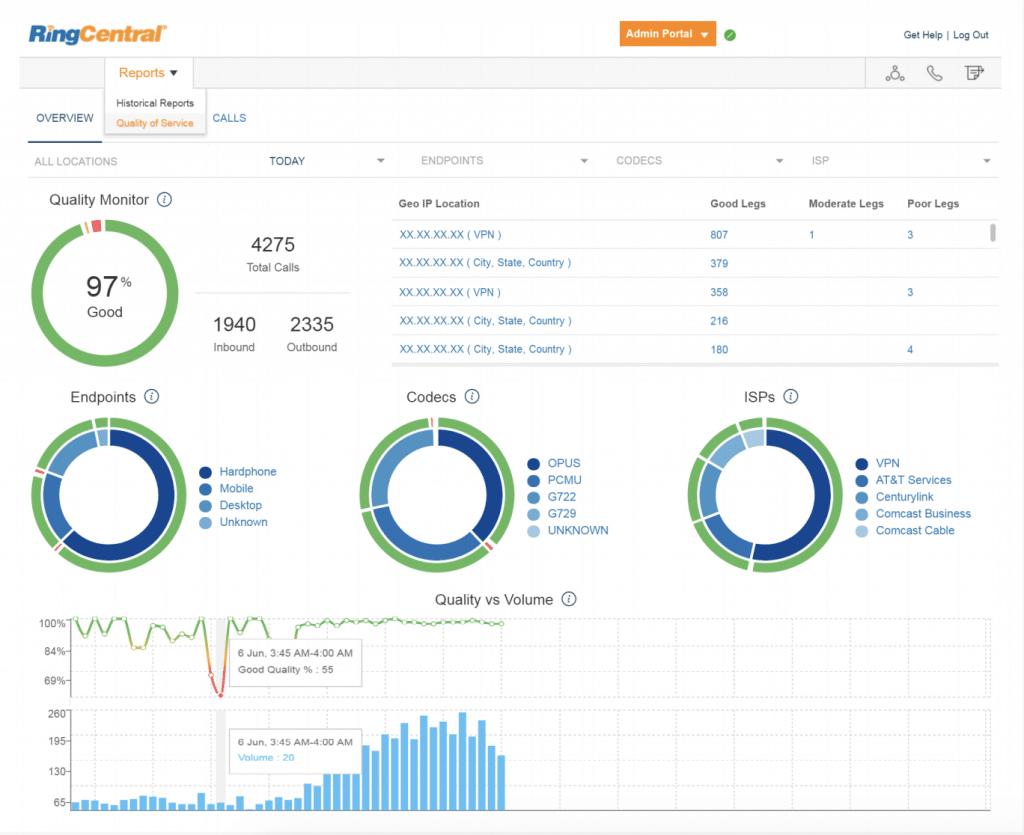You’d be hard-pressed to find a business that doesn’t claim to put their customers first.
But be honest: do you really?
Because buyers expect more than ever from the businesses they support in terms of service and support.
Reality check: it’s not enough to simply serve and “be there” for customers anymore. Teams today need to be able to predict their customers’ needs and deliver on them every time.
And the best way to make it happen is by adopting a customer-centric strategy.
In this guide, we’ll highlight how to make your business more customer-centric and how doing so results in long-term loyalty and growth.
We’ll cover:
- What “customer-centric” actually means
- How do you develop a customer-centric strategy?
- What does customer-centric support look like?
- What does customer-centric marketing look like?
🔑 What’s the key to building a customer-centric team? Grab our eBook to find out.
What does “customer-centric” really mean, though?
Being customer-centric is about more than cliches like “service with a smile” or “the customer is always right.”
A customer-centric business is focused on the experience at each stage of the buyer’s journey, using real-life customer insights and data to drive decision-making.
For example, a customer-centric company might be more likely to explore agile customer service practices—and even frequently feature actual customers in their marketing campaigns. These companies go beyond just serving customers; they make them integral to pretty much every aspect of the business.
[ebook-download title=”How customer-obsessed is your business?” link=”https://netstorage.ringcentral.com/documents/quiz_how_customer_obsessed_your_business.pdf” cta-text=”Take the quiz” src=””]
What’s the difference between “customer-centric” and “customer-focused?”
Fair question. The terms almost seem interchangeable, right? For some companies, there’s an important distinction. A quick Google search will show articles breaking down the difference like this:
Being customer-focused is reactive. This basically means making business decisions and changes to your strategy after something happens (think: a competitor launches a new product, or quarterly sales are down).
Ex: “Oh, our competitor is doing X so our customers must want Y!”
Meanwhile, a customer-centric strategy is proactive. When you concentrate on empathy and learning your buyers’ motivations, you can better predict and personalize your service for each individual customer.
Ex: “Based on our conversations and analytics, we know for a fact that our customers need X, Y, and Z.”
Honestly, those definitions seem a bit arbitrary and there’s nothing inherently wrong with knowing about and being both. That said, a customer-centric strategy requires the extra step of uncovering your customers’ motivations. This means moving away from “one-size-fits-all” strategies in terms of marketing and support.
Why having a customer-centric strategy is so important
Food for thought: we’re reaching a point where buyers are prioritizing experience over products and pricing.1 It’s well-documented that customers are more than happy to bounce to a competing company or service if you aren’t anticipating their needs.
Also, consider the financial incentive of being customer-centric. As noted in our guide to customer retention strategies, it costs significantly less to retain customers than it does to acquire them.
Not to mention that increasing your retention rate also means increasing your customer lifetime value (LTV), or the total amount of revenue a customer brings to your business.
The end result is long-term, happy customers—and a serious boost to your bottom line.
How do you develop a customer-centric strategy?
Putting a customer-specific strategy into practice requires a combination of customer service software, tools, and tactics. Here’s how to do it.
1. Develop a comprehensive understanding of your customers
You can’t anticipate your customers’ expectations until you’ve defined what makes them tick.
For example, what problems keep them up at night? What aspects of your service can’t they live without? Which other businesses do they support? Ideally, you should have a comprehensive understanding of your customer that’s agreed upon by your business at large.
This is where tools such as a user persona come in handy. Not only does it help you do a deep dive into your ideal customers’ motivations, it’s also prime for sharing with new employees who might not be familiar with your target audience:
2. Document customer insights to personalize your service
Fact: nearly three-fourths of consumers2 expect customer support staff to know who they are and have insight into their previous engagements whenever they reach out.
This means your business needs to go beyond spreadsheets and manual note-taking to keep track of your customer histories.
That’s why it’s so important for modern businesses to have a good customer service software that consolidates all that customer information into one place, ready for you to pull up whenever a customer calls you or sends you a message:
Another useful tool is a CRM (customer relationship management) platform, of course. Many CRMs integrate with business apps and phone services like RingCentral, making it a cinch to reach out to your customers on their preferred communication channels and further personalize your service.
This allows you to monitor insights in real time as you conduct customer calls. Here’s an example from RingCentral’s integration with Salesforce’s CRM:
An added bonus of using a CRM combined with a communications platform to log information is that you can naturally pass customers off to new team members if necessary without losing any crucial details along the way.
3. Make a point to share and discuss customer insights
Not only do customer-centric teams tend to do a good job of documenting insights, they also usually have an easy way of sharing this team knowledge on a regular basis.
From team meetings to training, your team should never be out of the loop in terms of how to serve individual customers or your audience at large.
Make customer service teamwork easy for your team by giving them a good communication tool so that they can share files and insights to address customers’ questions in real time. Most teams today communicate by sending each other messages, but if your tool has video calling and phone calling options as well, even better:
4. Integrate customer-centricity into your company culture
Creating a customer-centric and collaborative culture doesn’t happen overnight. It requires reflecting on the core pain points of your audience and making sure that your employees are committed to solving them.
This all starts with hiring and training employees who are genuinely empathetic and excel at problem-solving.
Customer-centric companies are also open to talking to customers candidly and directly, which leads to our next point…
5. Talk to your customers on a consistent basis
Seems obvious, right? However, talking to customers shouldn’t be reserved for times when there’s a problem or promotion at stake.
Again, it’s all about being proactive. Regular check-in calls, emails, and customer surveys are all essential to a customer-centric strategy. Not only does this show your customers that the lines of communication are always open, but that you also legitimately value their feedback.
How often should you check in, though? There are plenty of factors to consider, like your company size and number of teammates.
Regardless, keep a consistent outreach and check-in calendar—it can help you stay organized and manage your individual customer relationships.
What does customer-centric support look like?
Let’s look at some real-world strategies for providing customer-centric support.
Provide multiple support channels for convenience
Customer support should obviously be as straightforward and painless as possible.
But consider that your customers have pretty diverse preferences when it comes to support. Although some might prefer a direct phone-call, others might want a self-service portal instead. In a recent survey of US consumers, we found that after a purchase, the preferred communication channel is pretty even, at least for respondents aged 18-39: 28% of them preferred online chat, while 23% preferred email and 22% (surprisingly!) still preferred the phone.
The solution is to provide your customers with flexibility and options to reach out to you on their preferred terms. This is why omnichannel customer service is quickly becoming more than just a buzzword—we’d say it’s a customer service best practice.
For example, companies like Carvana provide a combination of an FAQ, tutorial videos, live chat, email, and phone support:
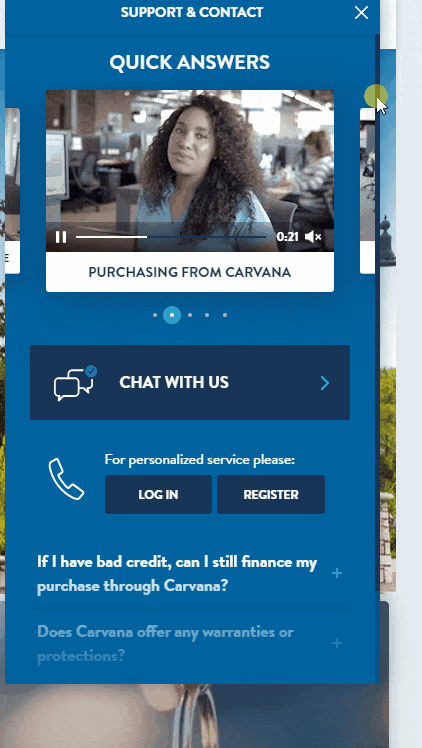
In other words, every customer is covered—no matter what they prefer.
Make sure your support is as timely as possible
According to data from Jitbit,3 the average response time to customer support tickets sits at around seven hours. Meanwhile, those same tickets can take up to three days to resolve.
Yikes.
These numbers are staggering, but they’re essential call center metrics that can lead you to win back lost or disillusioned customers.
This data also speaks to the need for support teams to, well, be fast. Don’t make your customers wait.
Learn more about first call resolution standards and why this metric is so important if you want to keep your customers happy.
If you have a contact center tool like RingCentral, for instance, you’d be able to instantly route calls to reps based on their skill and availability—without making your customers sit on hold for an eternity. There are even built-in analytics to help you understand how quickly you’re responding to calls and the overall quality of your service:
Go the extra mile with empathy
Empathy is among the most important customer service skills for a reason. When you show customers that you’re willing to go the extra mile because you understand them, they’ll reciprocate that dedication with loyalty.
Look at companies such as Chewy, an online pet supply retailer, as a perfect example. Chewy is well-known for offering free returns and exchanges in addition to sending clients personalized gifts at random. When something goes wrong, they go out of their way to make it right.
These seemingly small acts of kindness get a lot of love on social media. You don’t have to look hard to find posts shouting-out Chewy’s stellar customer support:
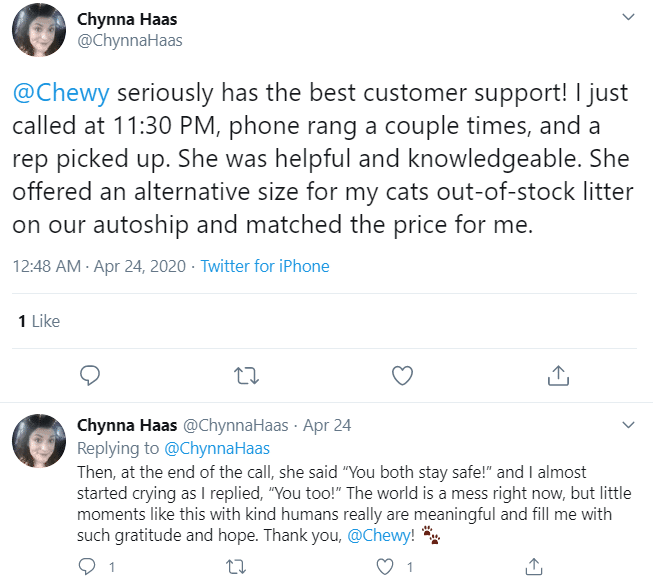
When you’ve reached the point where your customers are basically marketing on your behalf, you know that you’re customer-centric. At the end of the day, this level of advocacy is exactly what companies should strive for.
So, customer-centricity in customer service is pretty straightforward. Now, let’s look at how this translates into your marketing.
What does customer-centric marketing look like?
Here are some examples of how to combine the best practices of a customer-centric strategy with your marketing campaigns.
Personalized and recommended offers
Consumers today want to be told what to buy—and they’re willing to spend more money when they receive personalized offers.4 These offers are prime for higher customer engagement and represent marketing messages that resonate with customers by saying “Hey! We know you, you know us, and we know what you want.”
For example, here’s how OpenTable does it through recommendations based on where someone has eaten before:
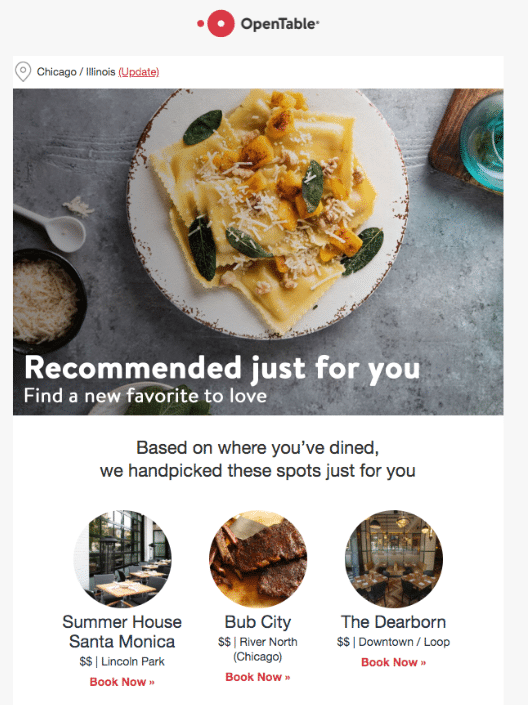
The ability to break down your customers’ previous buying behavior is the perfect way to recommend relevant products and services in the future. This is often done today through analytics platforms like Mailchimp’s analytics dashboard, which target relevant marketing emails based on customer demographics.
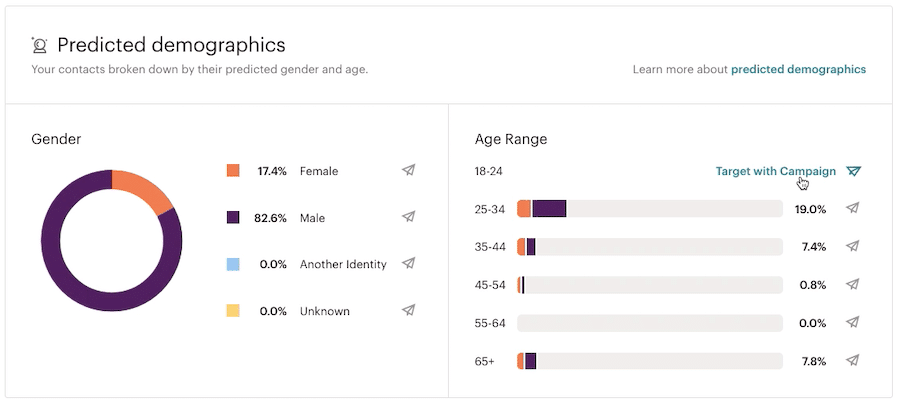
But, you don’t necessarily need to invest in fancy predictive technology to figure out what your customers want. For example, looking at your CRM or customer feedback can also clue you in on relevant offers and promotions to suggest to your customers.
Marketing messages focused on customer success and feedback
As we mentioned earlier, customer-centric businesses aren’t shy about talking to customers. Marketing campaigns focused on feedback (like survey emails) are a natural way to engage your customers and pick their brains:
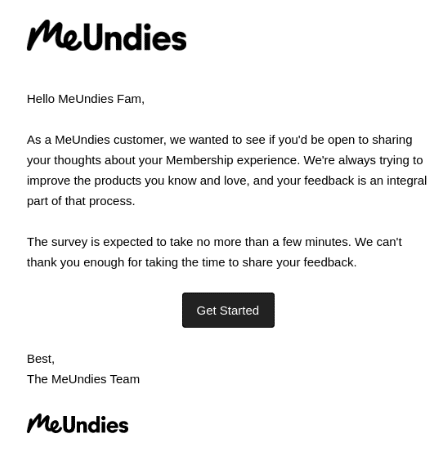
Even if your customers don’t respond, it’s a good look for your brand and shows that you’re making the effort to listen to what they have to say.
Customer shout-outs and “thank yous”
Keep in mind that social media interactions are perhaps the lowest impact in terms of customer interactions.
That said, regular social engagement can help keep your company fresh in the minds of your customers. The fact that customers are also relatively unfiltered on social media also makes it a great place to gather feedback.
If you want to be a more customer-centric company, make a point to regularly engage your social mentions including shout-outs, recommendations, and other comments. This shows customers that you’re listening and serves as a relatively time-efficient opportunity to thank them for their support:
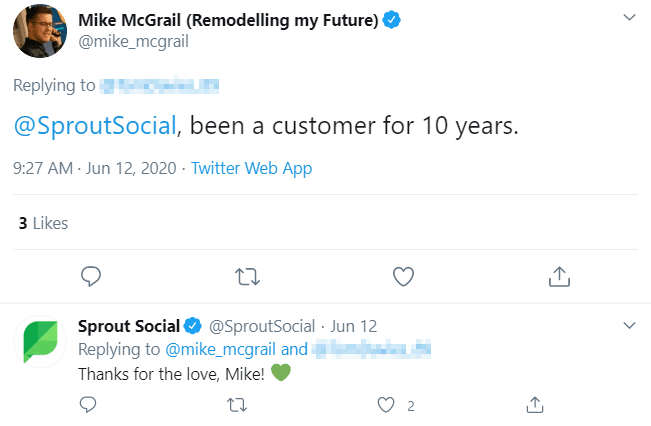
Does your business boast a customer-centric strategy?
Being customer-centric requires a commitment to your customers—but it’s worth it in the long-run.
With the customer service tips above (and tools like RingCentral), you’ll always have a pulse on your customers’ needs and be able to step up your service at a moment’s notice.
1 pwc.com/us/en/advisory-services/publications/consumer-intelligence-series/pwc-consumer-intelligence-series-customer-experience.pdf
2 info.microsoft.com/rs/157-GQE-382/images/EN-CNTNT-Report-DynService-2017-global-state-customer-service-en-au.pdf
3 jitbit.com/news/2266-average-customer-support-metrics-from-1000-companies
4 barilliance.com/personalized-product-recommendations-stats
Originally published Apr 16, 2020, updated Jun 26, 2024


